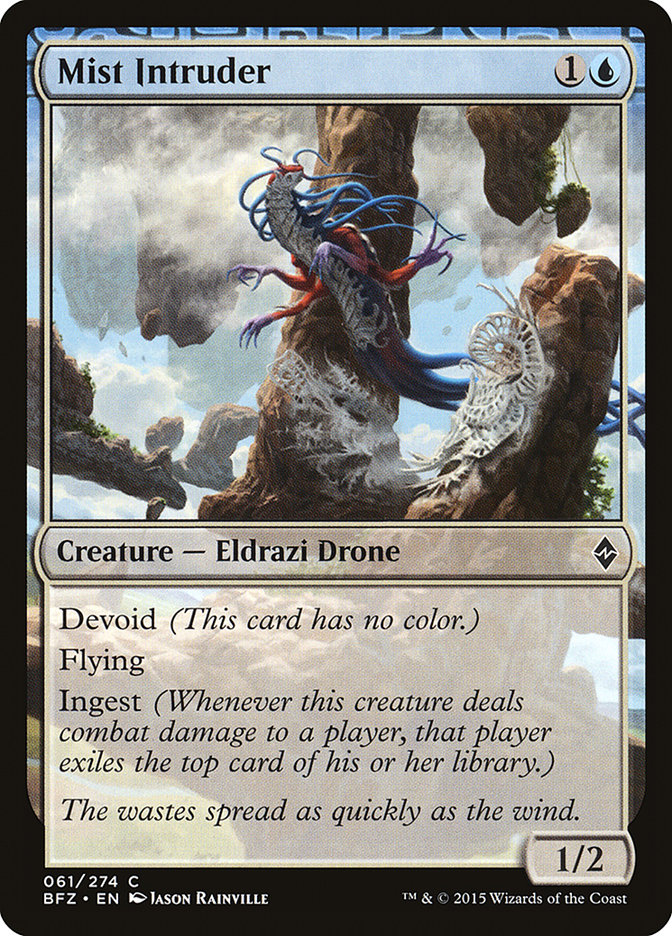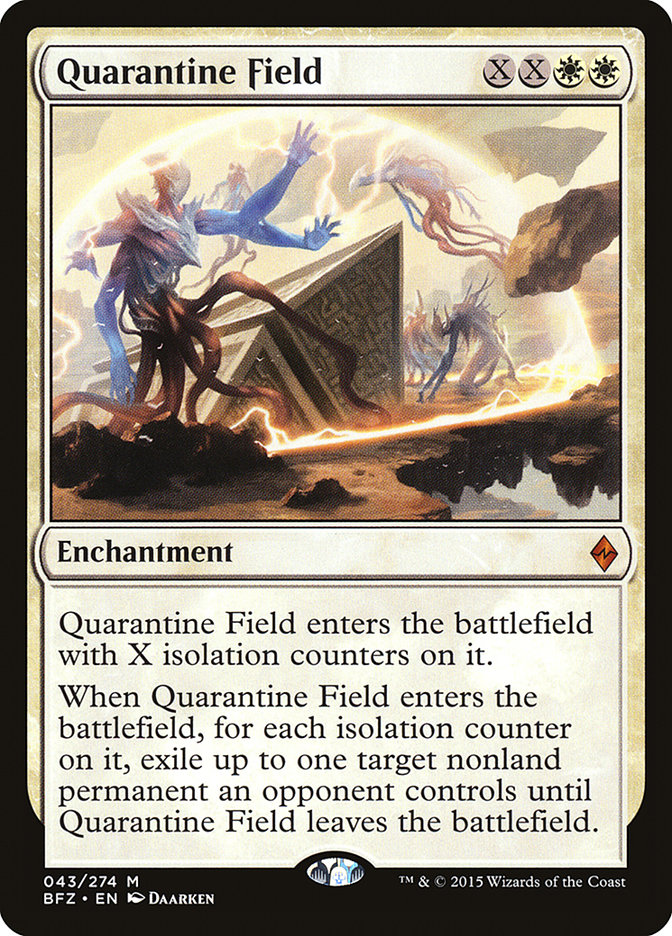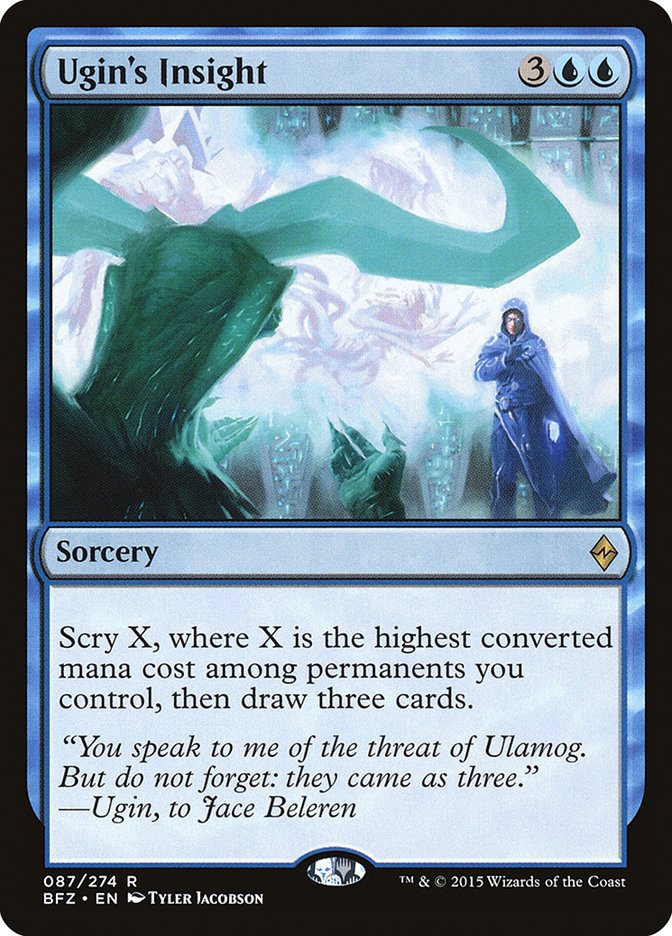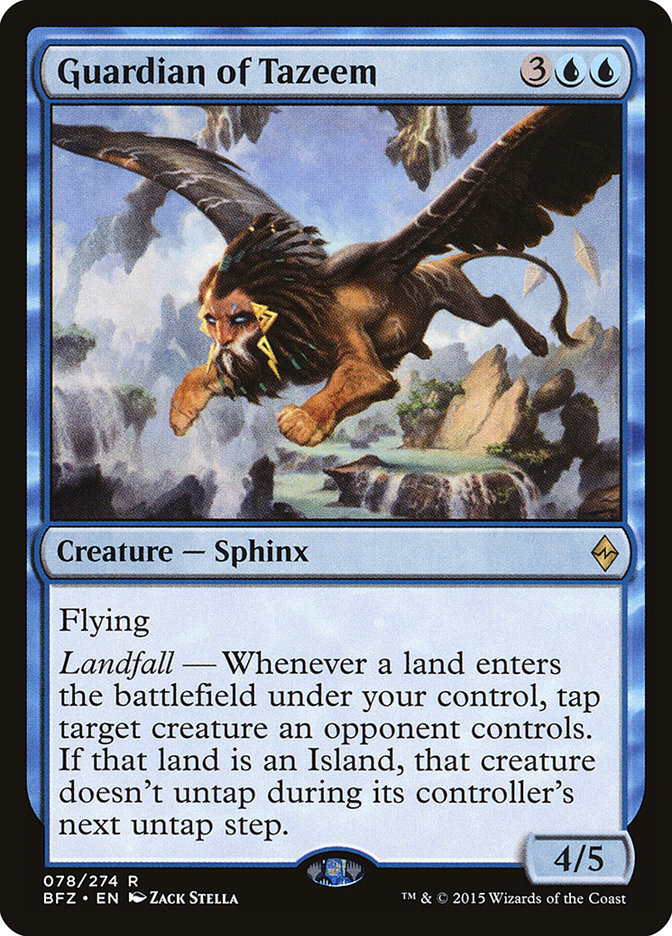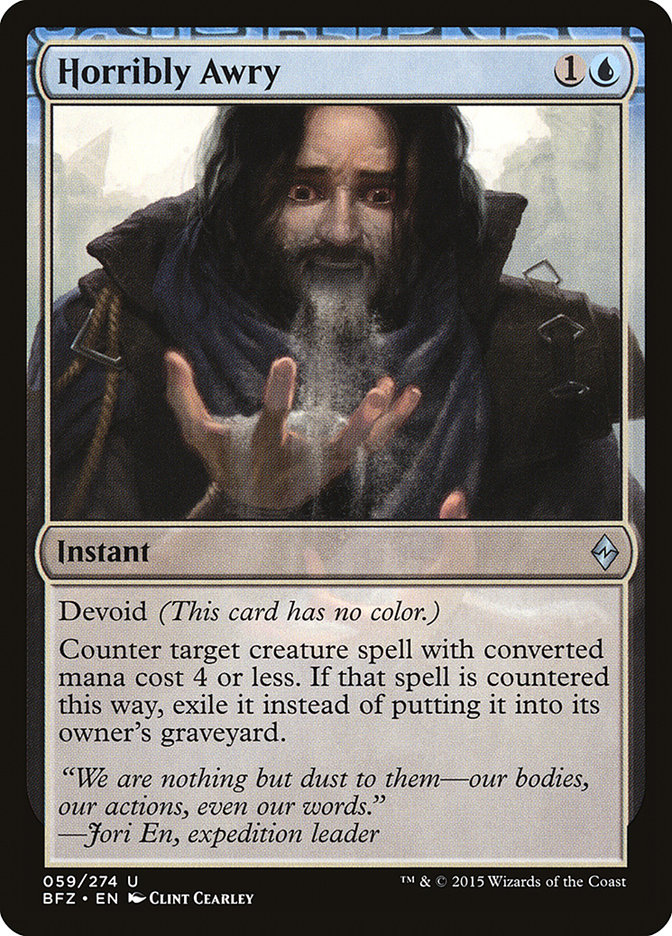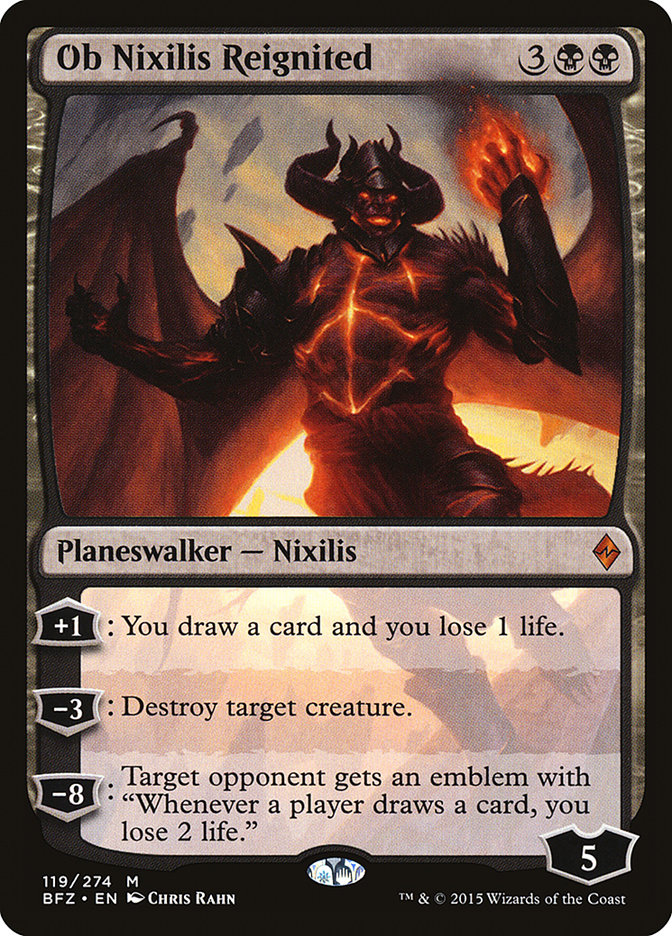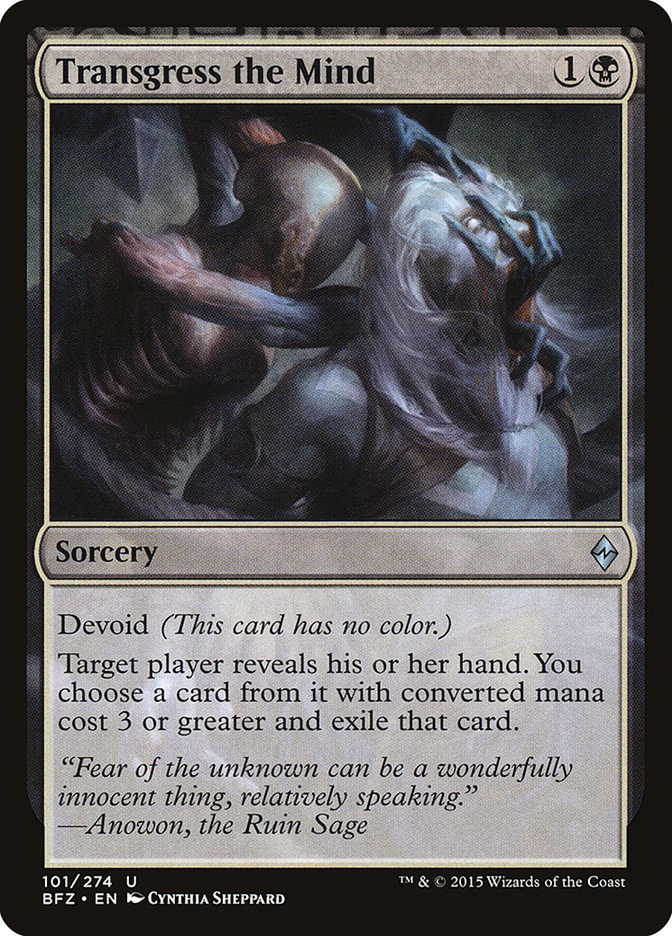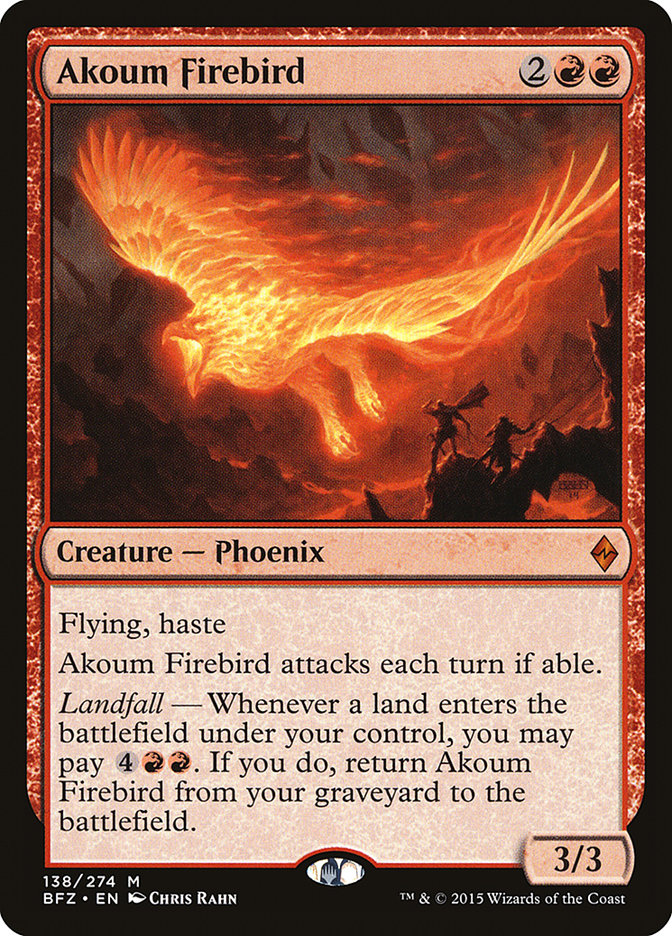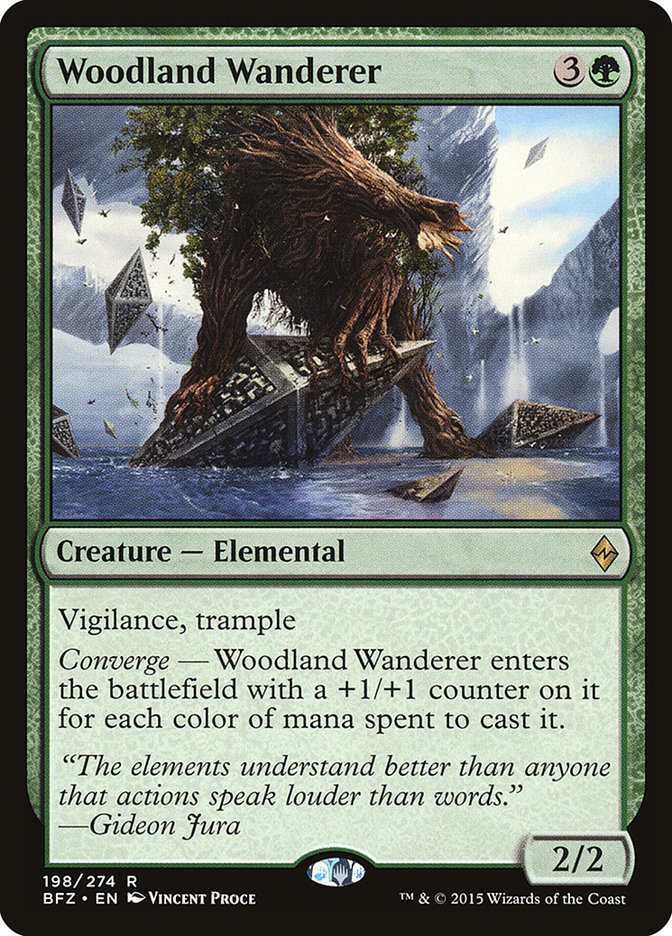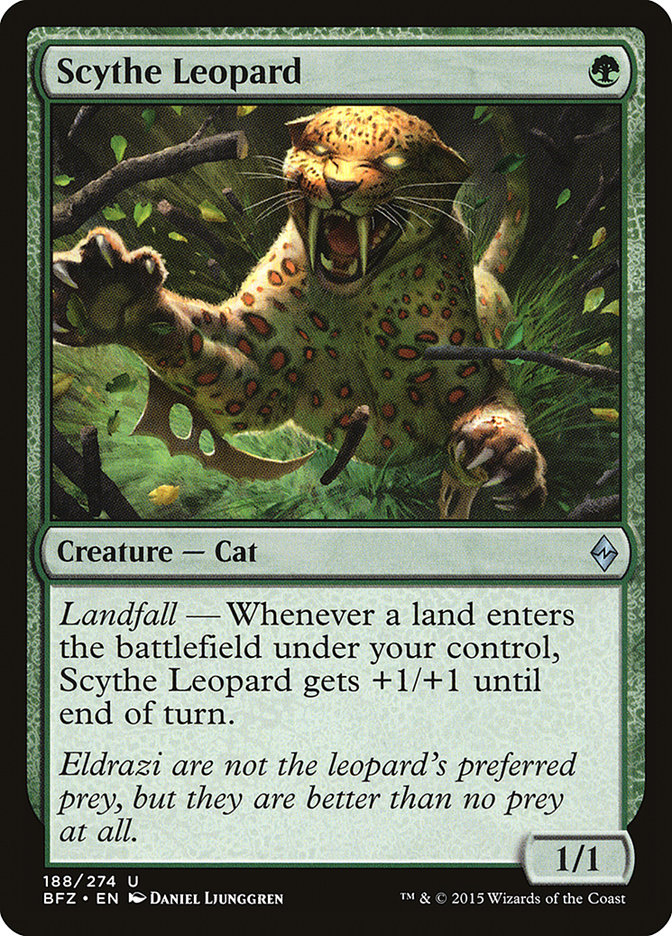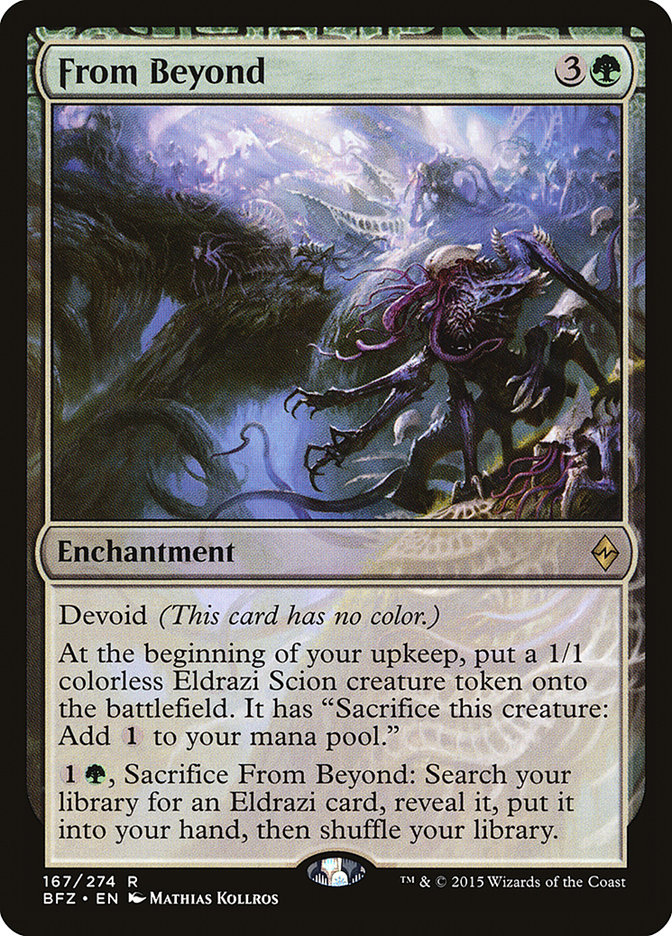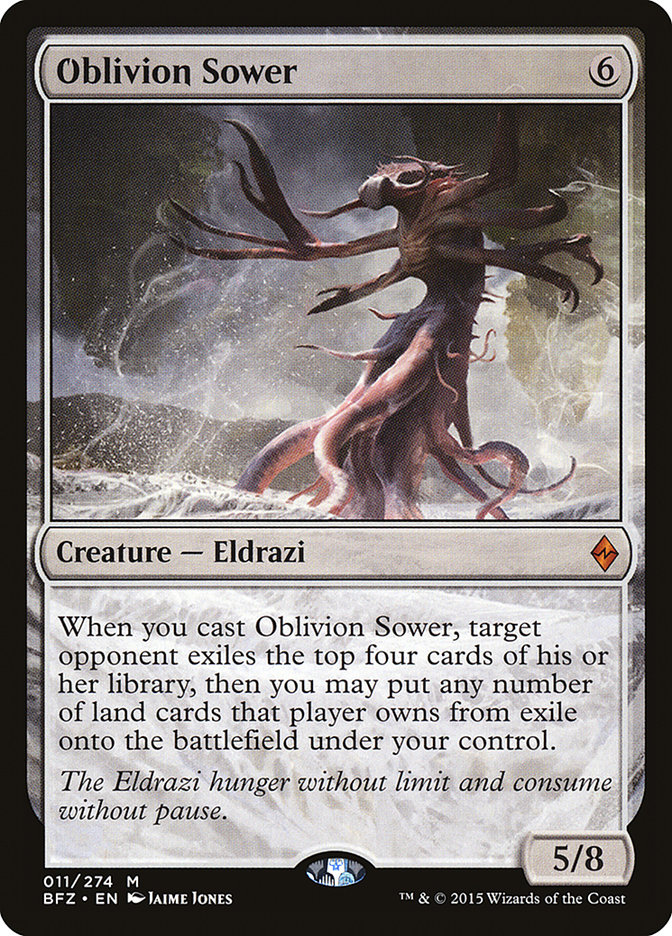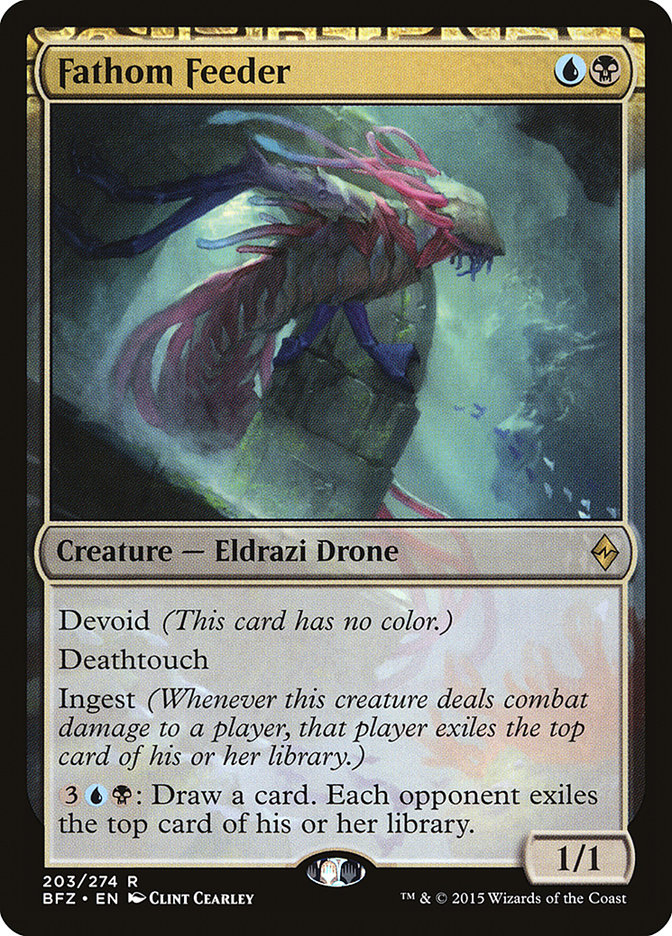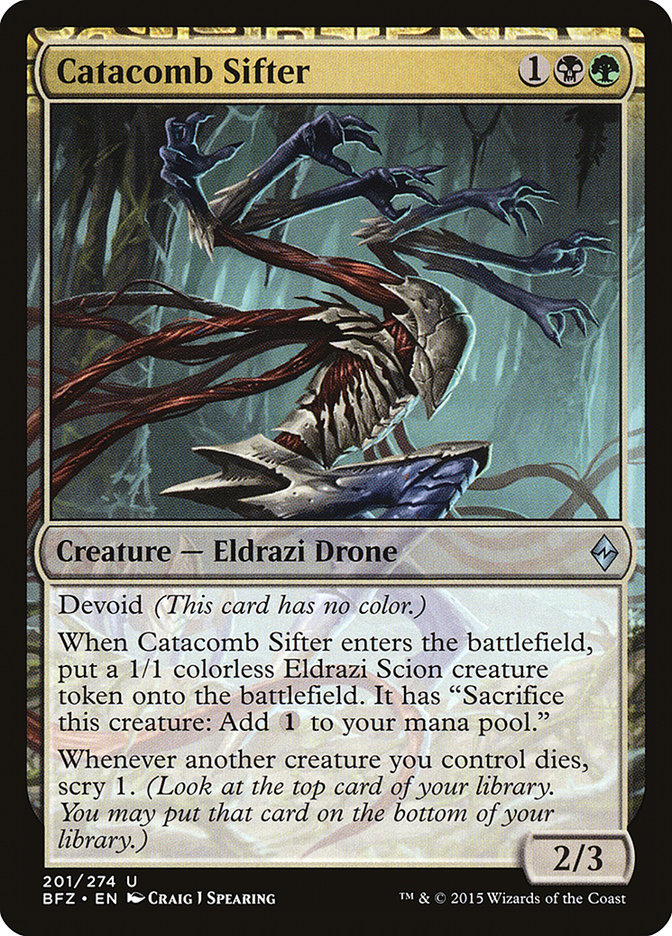I’m substantially more skeptical about Battle for Zendikar based on the portion of the set I’ve seen so far than I am for most sets. My basic
concern is that this set doesn’t seemed to have learned from the failures of sets like Champions of Kamigawa and Lorwyn. While other
tribal sets have been popular, Lorwyn, in my understanding, was a miss with the general public. I believe a substantial portion of that was that
most of the tribes it focused on weren’t supported outside of that block, so players who purchase just a few packs from each set wouldn’t find anything
they wanted to add to their existing deck. Basically, I think a set will be unpopular if a large portion of its cards and mechanics rely on other cards in
the set.
While Landfall and Awaken are relatively evergreen, Allies and Ingest/Processors only really play with other cards in this set. Even in Standard, where
players will have access to all of these synergies that exist, I’m worried that these themes just won’t work out. Devoid, I suppose, is another mechanic
that people don’t have reason to care about much outside of this set, and I’m not really sure they have much reason to care inside either. There are cards
that point to other colorless cards, I suppose, but at that point it basically just feels like a creature type.
So many cards in this set have several lines of text, and almost all of them read like flavor text, except that it’s all out of order–Devoid, which
everyone basically ignores when groking a card, comes first, then there’s maybe a keyword, and then Ingest, with three lines of reminder text, and what you
end up with is a really busy looking Storm Crow with upside in Limited.
Why only in Limited? Maybe there will be a way to build a Constructed deck around these since cards like Blight Herder actually look pretty good if you
assume they always work. The problem is, as I discussed last week, almost all the naturally
existing support in Standard, the cards that just happened to exile your opponent’s cards, have rotated out, so it looks like we’ll have to rely on Ingest
if we want our Processors to work. This means we’ll have to play with cards that have to hit our opponent in order to make other cards in our deck better
(playable). So how many Ingest creatures do you need before you can play a Processor, and how many Processors do you need before it’s actually worth
putting an Ingest creature in your deck? Also, once you’ve gone through the trouble to do that, your opponent will know that it’s important for you to hit
them with your Ingest creature, so they probably won’t let you do that.
Even being able to try to make this convoluted contraption work will require that they actually print enough Ingest creatures and Processors that are close
enough to playable to justify trying to push it, and if Fathom Feeder is the bar we can expect out of a rare Ingest creature, I just don’t believe that
these things are pushed for Constructed.
When I first heard that Allies were back, I thought maybe this would be like Elves in Magic Origins, where an entire deck worth of
creatures were printed in a single set, and maybe we’d start seeing Collected Company Ally decks. That’s not impossible, but at the moment, the Allies
spoiled include eight four- and five-mana Allies and four allies that cost three or less. I’m sure that ratio won’t continue and that the rare Allies are
the expensive Ally leaders and that we just haven’t seen the common Allies yet, but this is just so many top end Allies that I can’t really imagine having
a use for.
The theme for Zendikar is supposed to be “land matters,” but it’s interesting to pair that with “colors don’t”–sure, the mechanics make it seem like color
matters–Devoid is about color and Converge is about color, but really, Devoid isn’t about color at all, like I said earlier; it’s just a tribe–it has
nothing to do with what lands you have or how the game plays or any of the restrictions colors normally mean. Converge really just speaks to the
problem–yes, anyone can easily have access to any number of colors of mana.
Throughout Modern’s history, I’ve been an advocate for banning the fetchlands because I think those lands with duals that have basic land types just makes
mana too easy–you never have to consider other ways to build your manabase because that’s always the best, and you can always add another color if you
really need it. On top of that, most importantly, every game takes several extra minutes of busywork while players search and shuffle. They also
incidentally break delve as a mechanic. Now, all of that’s coming to Standard. This means that the best and highest impact cards in Battle for Zendikar will be the Battle lands that will have what I consider to be a directly negative impact on my experience playing the game, in
part because it will make playing all the powerful clan cards in Khans of Tarkir too easy, but mostly because of the added busywork to games of
Standard.
I spoke to Awaken and Landfall being evergreen mechanics that might bring wider appeal to the set. The problem is that Landfall appears to just be a toned
down version of what we’ve seen before–I think that moving from Steppe Lynx to Scythe Leopard is a good change for gameplay, decreasing the variance of
the card, but it’s certainly not flashy. Awaken is just the fortieth kicker variant, and I think its basic function in gameplay will be to end the game
faster when the midrange deck establishes control against the aggressive deck and to mitigate flood when two midrange decks play against each other.
Based on the cards we’ve seen so far, I think design has failed by removing the unique flavor of the Eldrazi and turning them into more generic enemies
while mechanically driving them with linked abilities that I don’t expect to play properly and by generally making the set too insular, and I think
development may have failed by just not including enough spells that can compete with the power level of the existing spells in Standard.
Last week, I streamed a bit of Standard, and several people asked which Battle for Zendikar cards I was most excited about, and I didn’t really
have an answer because I hadn’t really thought about things that way yet. I was just taking things in, I hadn’t really thought through them yet (I’m an
Ingester, not a Processor). I hate to be purely negative, so now I’m going to focus on what I’m looking forward to.
First and most importantly, I’m looking forward to a new Standard with different driving forces. I may like the way these lands play less than the old
lands in Standard, and I may think the old Standard is one of the best we’ve ever had, but I can still get into changing things up.It’ll be interesting to
see which of the old cards and strategies are best when the lands used to power them work completely differently.
But what people really seem to want to know is which individual cards I think we should focus on. I’m going to skip the Awaken cards. There are a bunch of
cards with Awaken that are very close to normal spells but that make a big creature later. All of them are good, all of them are a little better than they
would be if they didn’t have Awaken, and none of them are particularly exciting or worth talking about. With that said, let me get to the top cards of note
by color:
White
Everyone seems to agree that this is a very powerful card. I’m not sure if it’s ultimately better or worse than Xenagos, the Reveler, as haste is a pretty
big deal, and Xenagos’s +1 ability is actually outstanding, but the extra loyalty on Gideon is a very big deal, so it’s likely a little better. Either way,
Xenagos, the Reveler is a great card, so Gideon really can’t be that bad.
This card would be so good if it could be played alongside Nykthos, Shrine to Nyx. As is, I think it’s likely worse than Stasis Snare, but exiling
non-creature permanents is a big deal, and I’m sure casting this for six mana won’t be uncommon. I think this will be an important card, but it’ll most
likely be played in small numbers most of the time, though I could see playing four in a dedicated ramp deck.
Blue
The obvious card to compare this to is Jace’s Ingenuity, where we’re giving up instant speed to get to scry. How much do you have to get to scry for to
make it better than being instant? Well, that’s really going to depend on context. If we’re trying to never tap out, it’s going to be hard for this card to
be better. If we’re a tapout control deck with no counterspells, I’d probably take about scry 2. This card will often have scry 4-7 which is just an absurd
amount of selection. I think this is a more powerful card than Jace’s Ingenuity that will have fewer natural homes (the decks that want this effect tend to
really value instant speed). I expect it to see play, and I think it’s a card that Cube owners should strongly consider adding to their Cubes.
I think we’ve gotten to the point where a 4/5 flier for five is no longer anything special, and I don’t really expect this card to see a lot of play (I’d
be more surprised if it saw a lot of play than if it saw no play), but it’s worth noting how effective this thing is as dealing with creatures when you
fetch an Island on their turn and make a creature skip two attack steps. Basically, I think there’s a chance that this thing lines up against Eldrazi the
way that Frost Titan lines up against other titans, but I wouldn’t count on it.
This card is generally worse than Essense Scatter/Remove Soul, especially as it exists in a world where creatures that cost more than four mana are
reasonably likely to be very important, but I think we’ve wanted a Remove Soul for a long time. This might be good enough, especially since it’s ideal as
an answer to Deathmist Raptor and Den Protector specifically. It also gives me some hope that we’ll see enough cards that incidentally remove things that
we might not need to lean entirely on Ingest to get our Eldrazi Processors to work.
Black
So the +1 is a slightly bad version of Jace, Memory Adept but where we end up one loyalty ahead, and the -3 is a defensive ability compared to Jace, Memory
Adept’s aggressive ability. Given that making a planeswalker that draws cards is a solid way to press an advantage when you’re ahead, Ob Nixilis is a more
well-rounded planeswalker than Jace, Memory Adept. That said, no one played Jace, Memory Adept because it was well-rounded, people played it because it
broke control mirrors. Jace, Memory Adept wasn’t far from maindeck playable, and Ob Nixilis is much stronger as a maindeck card, so I think it’s pretty
safe to bet this card will see play despite how imperfect comparing cards to other cards that existed in entirely different contexts can be.
It’s hard to go from Thoughtseize to paying two mana for a limited selection of cards, but like Horribly Awry, this might be an important enabler for a
deck, and the fact that this can hit three-mana spells means that it usually will get what you need, and exiling will be important. I think this card will
see quite a bit of play, but if a deck doesn’t need it to set up processing, it will probably generally be in the sideboard.
Red
Is a 3/3 haste flier for four good? Probably not, but this card is very serious about coming back. Six mana to bring it back to play just isn’t that much,
and while we’re losing Satyr Wayfinder, we can still play Gather the Pack or Jace, Vryn’s Prodigy to put this into the graveyard for free. This card puts a
huge pressure on control decks to be able to exile a creature going long, but I think between Abzan Charm, Titan’s Presence, and Stasis Snare, they were
likely planning to be able to do that anyway.
Green
This card seems great. I generally wanted to wait until I had five mana for Den Protector, and this only costs one more than that, and the ability to
choose between trying to loop these or just getting another card when it dies is outstanding. This is basically just a six-mana three-for-one, which is
exactly the way I want to see expensive creatures designed.
As far as big dumb idiots go, this one is very big. I honestly don’t know if that’s good enough, but I like that it’s a direction people can choose to go
with their four-mana green creature.
I think there’s a high chance this card isn’t good enough, but I really want to be able to try to build around +1/+1 counters matter, and this feels close
enough that it might let me do that. Also great with Hardened Scales.
I’m not really a Wild Nacatl kinda guy, but I’d like to see more aggressive options in Standard.
I’ve never liked Awakening Zone. Sometimes I’ll grudgingly take it and put it in my Cube deck, but I’ve never really been into it for reasons I don’t
understand, and this is similar. Yes, it seems very good at what it does, but it’s not a card I really see myself playing.
Colorless
What’s not to like here? It’s a big sweet Eldrazi that’s not that unfair to cheat into play. I hope people actually get to cast this in Standard
moving forward.
I really want this card to be good. I really like its style. It’s like a Primeval Titan that isn’t broken by being able to find specific lands.
Eldrazi-Gang Commander, like Siege-Gang Commander but huge and with a little bit of Skirk Prospector in the mix. I really hope to be able to play this
card, but I think I need to see a few more good enablers.
I’m hoping this turns out to be a good enabler.
Gold
As I mentioned above, I don’t really think this card is good enough, but I have a bit of a soft spot for small deathtouch creatures, so I think it’d be
awesome if this thing is actually playable.
This is another one that feels like it’s just on the cusp of playability rather than being a slam dunk, but I’d love it if Standard was about cards like
this, and it’s good enough that I think there’s some chance.
All the lands are great, but none of them are exciting.
In general, I think what I’m really looking for in Standard right now is good one- and two-mana plays, since Khans of Tarkir offers so many good
three- and four-mana plays, and it’s likely that a lot of those will be common, so I have hope that we’ll still see a good one-mana black removal spell or
some of the good aggressive creatures we’d need to really change the format.

